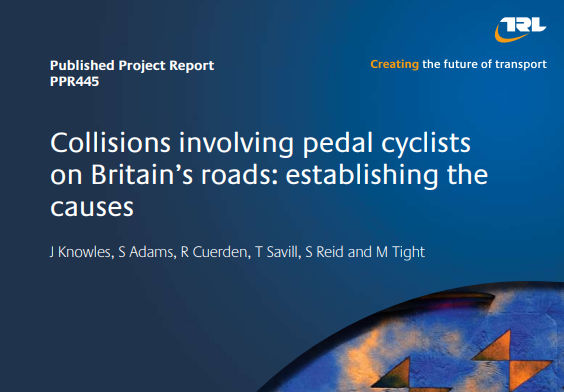Cycling Collisions - and How to Avoid Them
Fear is often cited as a reason to avoid cycling. But how big is the risk, what are the main hazards, and how can they be mitigated?
Government statistics show one reported injury for every 250,000 miles cycled.
(That's one injury in 87 years if you cycle 10 miles every day.)
The most high risk scenarios from this
report are summarised below:-
-
You might be surprised to learn that overall the responsibility for cycling accidents is fairy evenly split between cyclist and motorists, with young cyclists' behaviour counterbalancing the caution of more experienced cyclists. Report page 33.
(Could the 'immortality of youth' be offset by more cycling training at schools?)
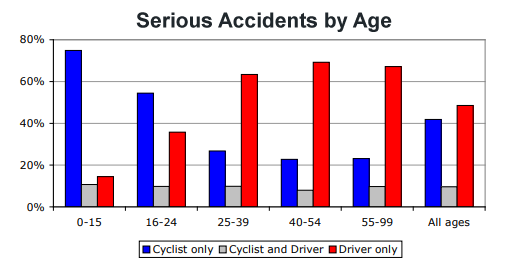
-
Whether the accident is attributed to the cyclist or the motorist,
in both cases 'Failure to Look Properly' accounts for around 50% of collisions.
"Sorry mate, I didn't see you" is heard many times.
Vision and visibility, looking and seeing, are critical to cycling safety. -
Half of cycling collisions are head on, which means an observant cyclist might be able to avoid them.

-
A common fear is of being hit from behind, perhaps because (as horror film directors know) we have an inate fear of what might be happening in our blind spot. In fact only 14% of cycling collisions involve being hit from behind. Some of these will involve poor visibility at night, or unexpected changes of lane by the cyclist.
Motorists rarely drive into what they can see directly in front of them.
-
Two thirds of all cycle accidents occur within 20 metres of a junction, where motorists are principally looking for other motor vehicles, and often do not see cyclists.
-
Motorists' perception of the speed of other road users is affected by size.
It is common to over estimate the speed of large vehicles, and under-estimate the speed of cycles.
All the above factors contribute to these risky scenarios:-
Junctions
-
Pulling out from side roads in front of cyclists.
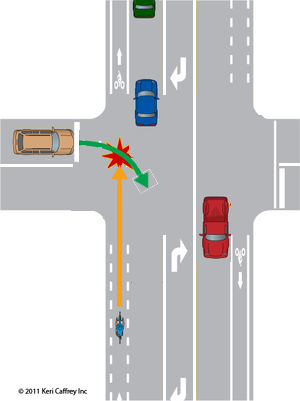
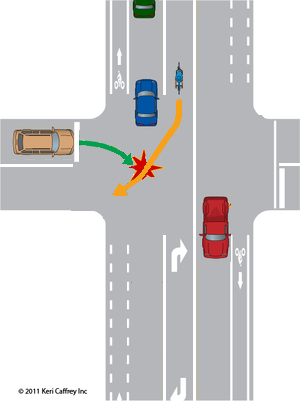
-
Turning right from a main road in front of cyclists.
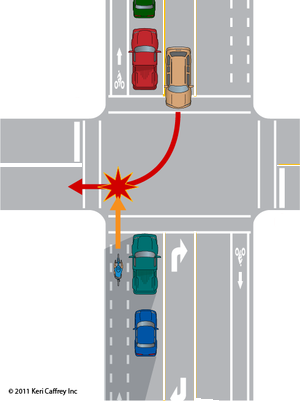
-
Turning left from a main road before completing the overtaking of a cyclist.
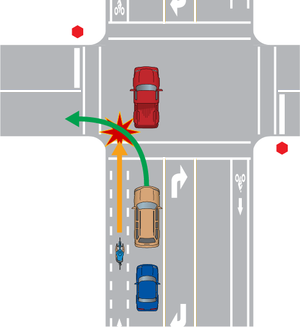
-
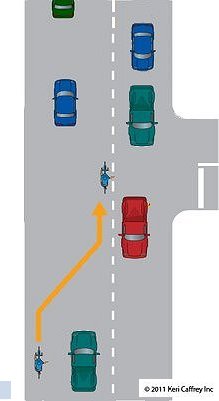 Cyclists
often feel most exposed when turning right off a main road.
The highway code advocates signalling and moving to the centre
of the road, as shown.
Cyclists
often feel most exposed when turning right off a main road.
The highway code advocates signalling and moving to the centre
of the road, as shown.
But it is often difficult to get a good view of traffic approaching from behind, and if there is no gap in the oncoming traffic, the cyclist can be stuck in the middle of the road with traffic passing on both sides.
It is often wiser to pull in to the side of the road, and wait for a gap in the traffic.
Roundabouts
-
Roundabouts account for about 20% of all serious cycling injuries, and in Macclesfield this statistic appears to be supported by BikeData -
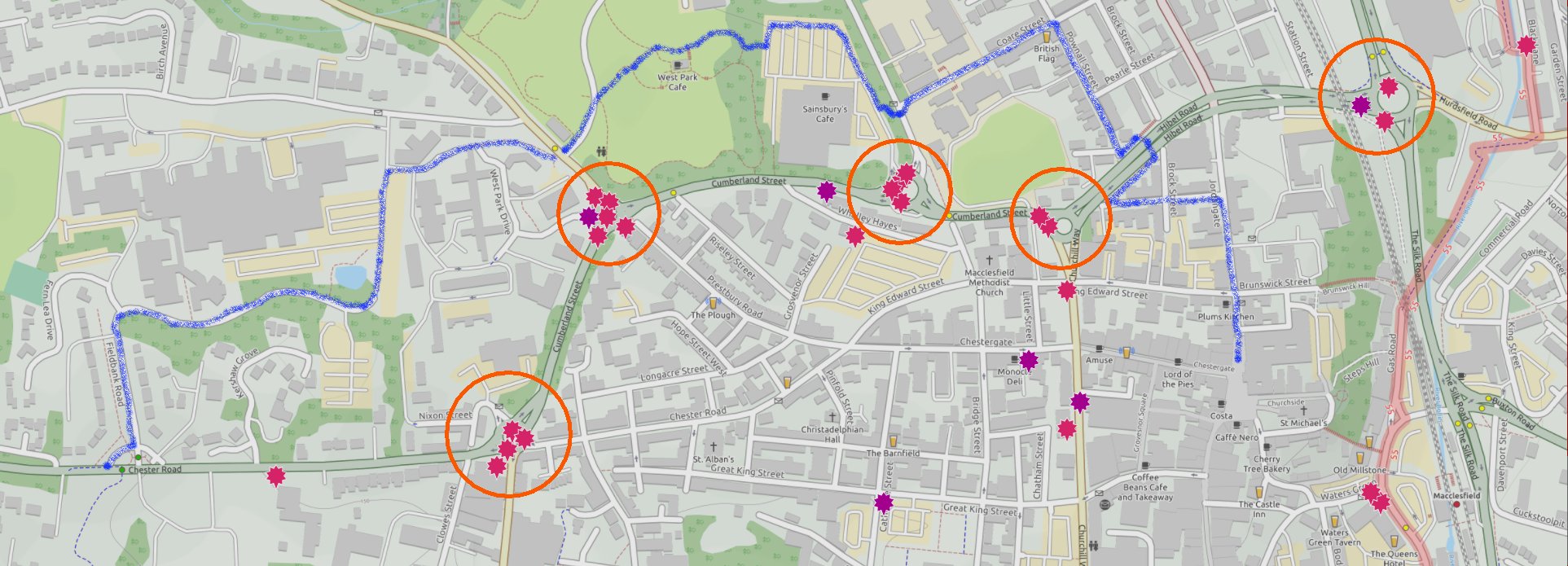
Turning left is not so bad, but any other direction is quite exposing.
Drivers tend to be preoccupied with dodging other cars, so cyclists should be highly visible or, if on a regular journey, should try to find a better route.
In Macclesfield, our Blue Route into the town centre dodges most of the roundabouts.
Being Overtaken
This is not usually a problem, but motorists sometimes get it wrong when they underestimate the speed of a bike, and underestimate how long it will take to complete an overtaking manoeuvre before reaching a narrowing of the road or oncoming traffic.
-
It is generally recommended that you ride about 75cm (or 2'6") from the kerb.
-
Riding too close increases the risk of punctures from thorns, broken glass, sunken grates, and potholes.
-
Riding too far to the left is 'invitational', tempting following cars to overtake when maybe they shouldn't.
-
Also, if a vehicle does pass too close, you need 'avoidance' room on the left to move into.
-
If your pedal hits the kerb on a downstroke the whole bike may be kicked upwards and outwards.
-
-
The cyclist is well advised to signal early an intention to occupy the lane until the bottleneck is passed.
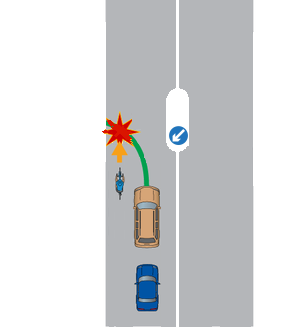
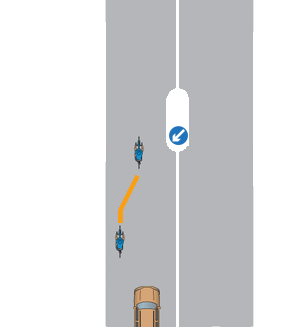
-
Lorries and buses are more than twice as likely to pass too close to a cyclist, and of course, big vehicles are much more intimidating.
-
Perhaps the problem is due to the limited vision via mirrors, or the length and poor acceleration of a large vehicle. Either way, the drivers of these vehicles need to be particularly careful when overtaking cyclists, and there are HGV training courses with this aim.
-
As a cyclist, if you become aware of a commercal vehicle beginning to overtake you, it could be wise to reduce your speed so that the manouevre is completed more quickly.
-
If you are unsure of a driver's intentions at a junction, look at their face.
If they look in your direction, they may have seen you;
If they don't look your way, be very careful. -
It is wise for cyclists to assume that they have NOT been seen, and that their speed is underestimated.
Traffic islands and pedestrian refuges cause a narrowing of the carriageway.
Car Doors
Parked drivers or passengers sometimes don't see bikes approaching from behind, and
throw open a door into the cyclist's path.
Cyclists need to ride about a metre clear of parked cars.
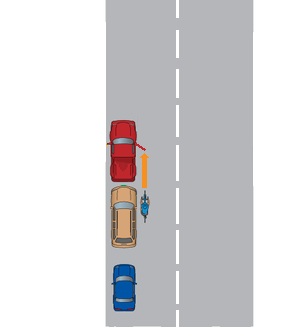
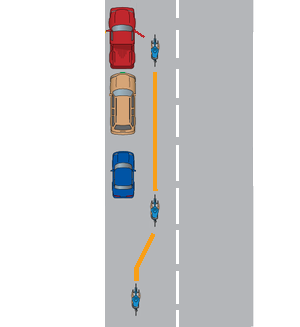
(When you are a car driver yourself, you should open your door with your left hand. The shoulder rotation makes it easier to see behind.)
Assumptions
It is quite reasonable for cyclists to expect other road users to follow the highway code, but it is wise to ride with a healthy scepticism.
The next page explains what you can do
about being noticed.
Contact: cycling@maccinfo.com



